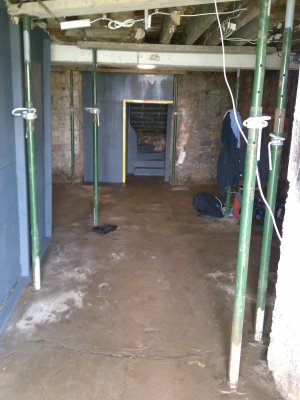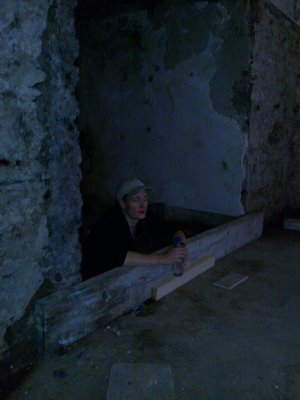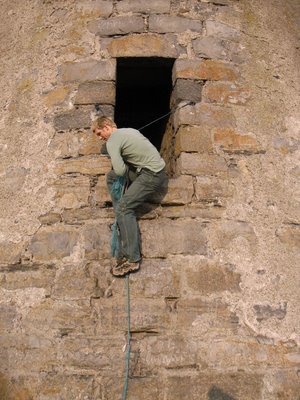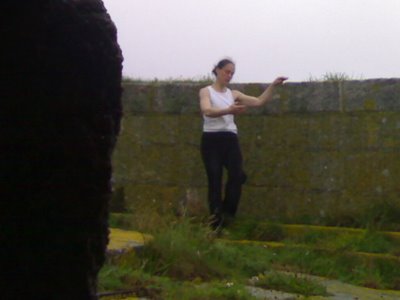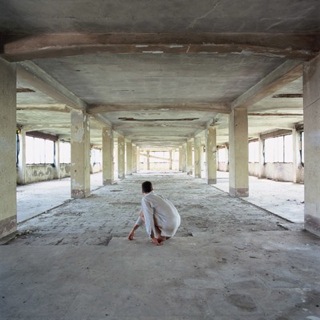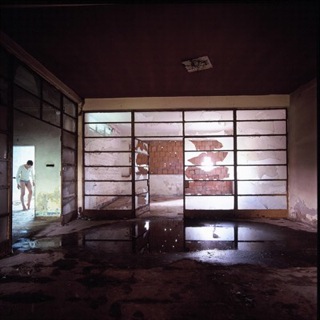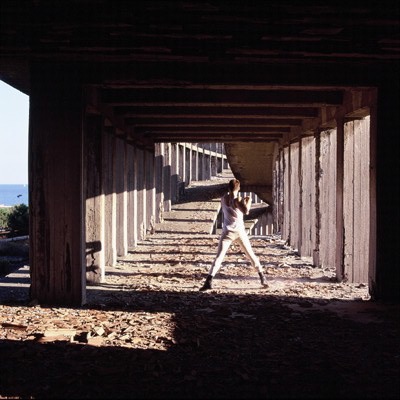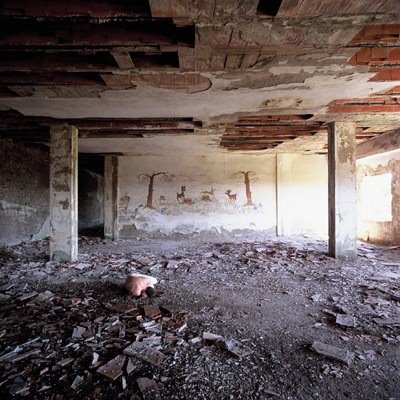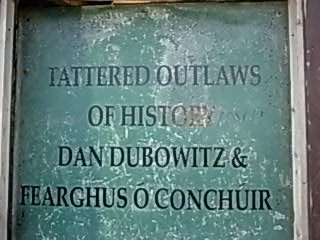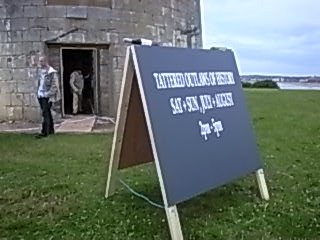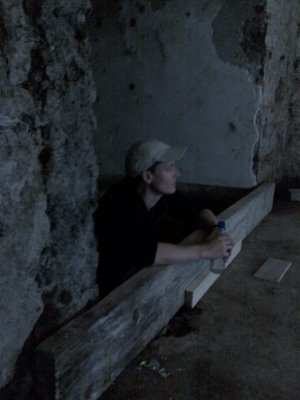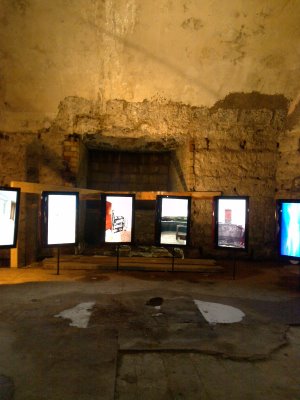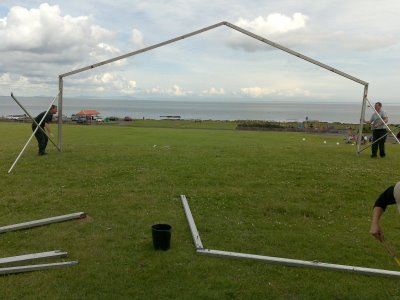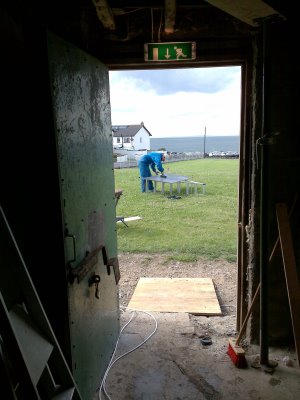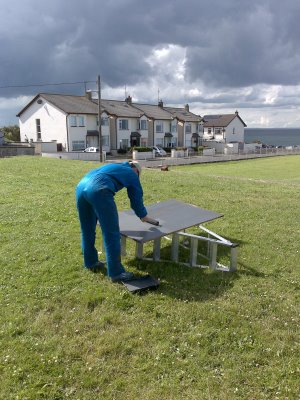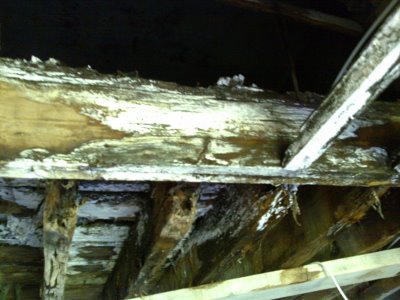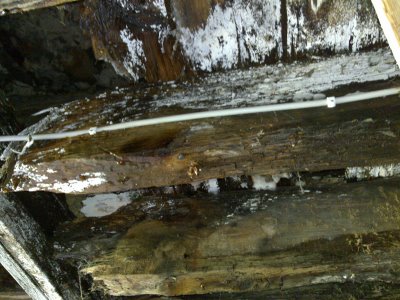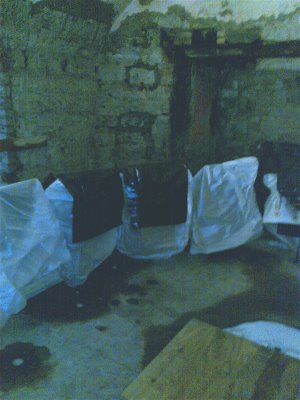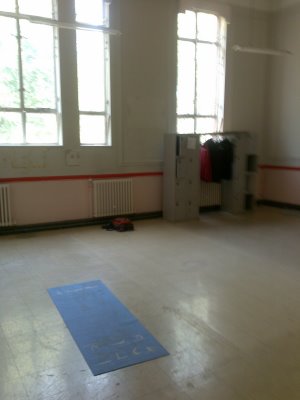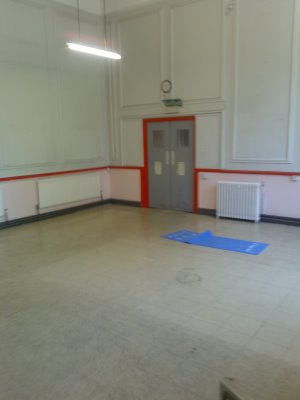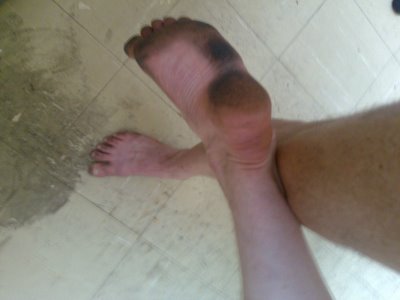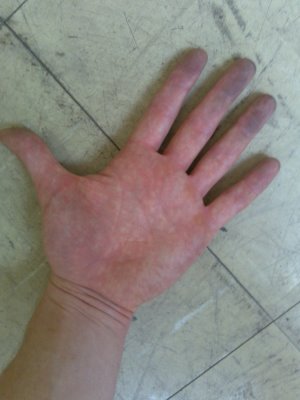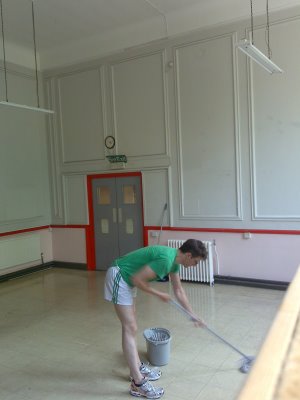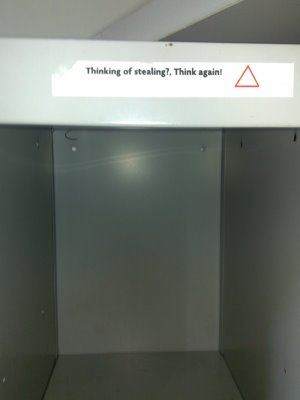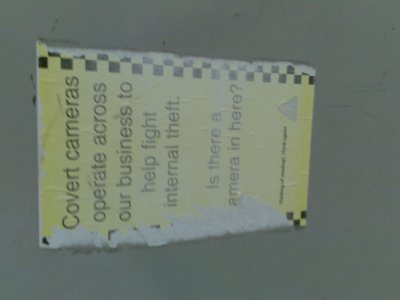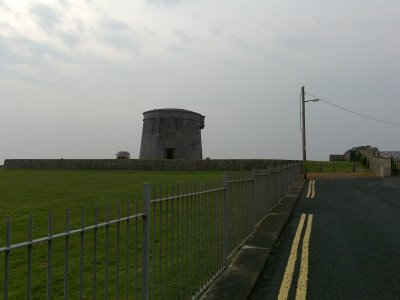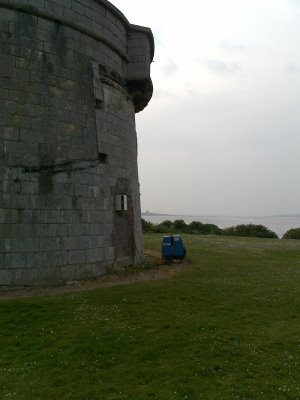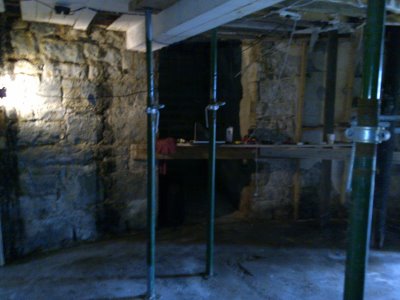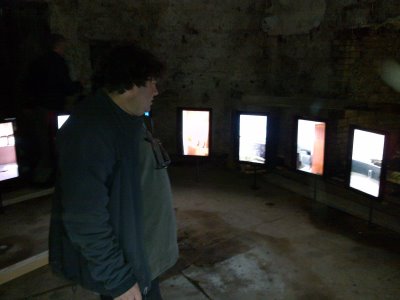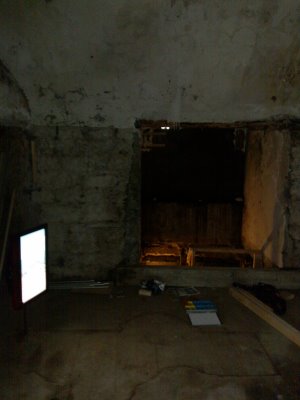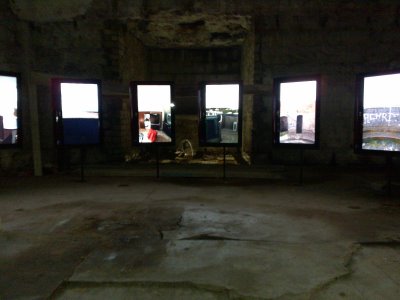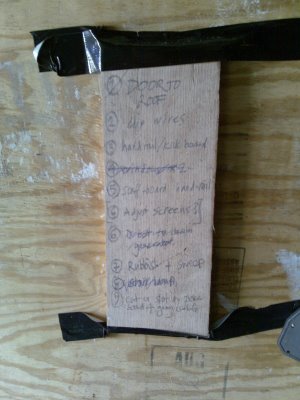Dialogue
Posted by Rebecca King, Fri 07 Aug 2009Rebecca King enjoys a thoughtful dance-chat.
Fearghus O Conchuir studied at Oxford University before going to London Contemporary Dance School; this is an unconventional way of training as a dancer and indeed Conchuir’s Dialogue is an unconventional piece. O Conchuir works with musician Yin Yi and fellow dancer and choreographer Li Ke to create a relaxed, tranquil piece which utilises technology to the full.
When the audience enters, the dancers and sound artist are pre-set onstage, sitting around a small table which also holds Yi’s laptop, which will generate the music for the show. There is also a portable video camera and a projector, and at one point Ke films the contours of her own body from her own perspective, live footage of which is projected above the dancers, making for striking, memorable viewing.
Footage of both moving dancers is projected along with their dancing shadows. Dialogue is not only a danced and verbal conversation between three people, but also an exchange of ideas between different media. You won’t be blown away by virtuoso tricks but you will be struck by the intelligent, experimental nature of the piece – this is essential viewing for those who like their dance thoughtful, quirky and intimate.
Label: Fearghus Ó Conchúir
Dialogue in Edinburgh: First review in The Skinny
I won’t be taking the lead.
Thank you for your submission to Artists taking the lead.
I am sorry to inform you that your idea has not been shortlisted.
We received in excess of 2,000 submissions and the artist advisor panels faced a real challenge in deciding a shortlist of just 60, as there are were many exceptional ideas to choose from.…
We understand that you will be disappointed by this outcome.
We hope this may be the beginning of a journey for your project, and we wish you every success in the future.
It’s easy to write about the successful projects that get national media coverage but I thought it might be worth sharing an unsuccessful application.
I was excited to think about submitting a project for the Northern Ireland Taking the Lead Olympic commission. The idea is one that came to me a couple of years ago when I visited the pssquared space in Belfast and during my trip there got to see the Thompson Dry Dock where the Olympic class liners, that included the Titanic, were built. The fact that shipbuilding connected Northern Ireland to the world, seemed like a good starting point for an Olympic idea. The other thing that struck me when I saw the dock was that it was bisected by a low wall on which the ship’s keel would have rested. This bisecting wall has particular resonance in Northern Ireland but it also made me think about individuals and groups, men and women. I imagined a single older male dancer on one side and hundreds of young female Irish dancers on the other. I imagined the girls with angle-grinders. You can see that it mightn’t have been the most attractive option for the artist advisors, but there’s still something in it that I want to work out.
Maybe the dry docks won’t have me but there’s still a place for the solo man and the hordes of Irish dancing girls and their angle grinders.
Tattered Outlaws: Choreography
I suppose I was concerned that the TV coverage of Tattered Outlaws didn’t really mention anything about the choreography. But then I realised that by focusing on the opportunity for people to get inside the towers and to reflect on what that heritage means, the coverage is acknowledging the most important aspects of the choreographic work. For the people who enter the tower, the experience is a structured physical experience. They shift from the relative warmth of the outdoors to the towers cool damp interior. Their eyes must adjust to the interior gloom. They may queue until it’s time to stoop carefully to climb the switch-back stairs we’ve built until the arrive on the viewing platform in front of the screen. Only six adults can fit on the small platform at a time – it’s a dance which many can experience but not as a big group. Standing in front of the screens, the viewers are encouraged to connect beyond the immediate physical experience of the Skerries tower (they rain my drip on them) to the other towers and to performances glimpsed on them.
This experience of visiting the installation corresponds to my own physical engagement with the tower. They came alive to me when, on the advice of some passing schoolboys, I was able to climb in to the tower at Loughshinny and make my way on to the roof. The physical buzz of climbing into the towers, the nervousness of making my way around the spiral staircase in the dark, the emergence on to the roofs which open to the sea and the surrounding coast, dark, light, sunshine, rain, all fed in to the dances I made for the films.
After those initial visits to the towers I went back to the studio to develop some physical material, phrases of movement that had enough nooks and crannies for me to explore each time I danced them. I brought that material to the towers for the filming and adapted it to each tower, the conditions I found there and the feelings evoked in me by the encounter between my movement and the place.
When you dance in a studio and on a stage, for the most part, there is a relationship between the movement and the space that you can take for granted. The floor will be even, with a particular texture. Dancing on the towers is a constant dialogue between the movement I’d prepared and what the tower offered. For the most part, I danced in the derelict towers. There’s broken glass, rough stone, grass, bird shit, steps, wind, rain. So each time I put my foot down and slid and rolled, my intention was challenged by the tower. In an instant, I had to adapt and a whole new set of images, memories, feelings flooded my body. I may have prepared the material but there was nothing predictable when I brought it to the tower. Though the tower is strong and my interaction with it temporary , I leave traces of myself on it, small bits of my DNA scraped off, pebbles shifted, grass disturbed – small, impermanent traces – but tokens of my presence nonethless.
Bernadette’s encounter with Balcarrick followed the same process. Her material is prepared but transformed by what she finds in the tower. Her DNA in the smeared in spit on the surfaces of the tower.
And why the other people? Zach and Eva play, a kind of connection between imagination and physical exploration that I think is a good way to help people understand what the ‘dancers’ are doing. Dorothy tells the story of her personal history with the tower. Hers is a process by which memory becomes movingly present, a process we can read in her body as she circles the tower to keep up with the camera, making sure that it hears what she wants remembered. Joe, at his bench calls each of the towers in turn with his Morse code. We know there will be no response but the gesture of calling is important nonetheless. 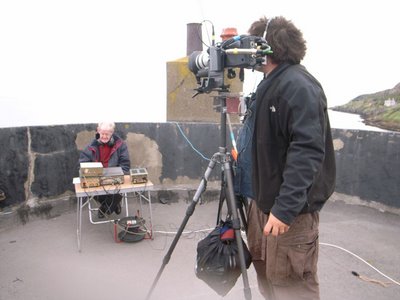
And Tom, reading his book, silently, is also a renowned broadcaster. He is the owner of the tower but his background in communication makes him an appropriate presence. I read in his stillness a calmness and self-assuredness that provides a counterpoint to the fretful physical explorations elsewhere in the films.
Tattered Outlaws: On the RTE 6 o clock news
A friend of mine was tickled by the sight of Dan and me side by side at the start of this piece. The physical differences between us are matched by differences of approach and temperament, however Tattered Outlaws has been about connecting the different and acknowledging the common DNA of buildings/people/experiences that don’t look so similar on the outside.
I’m always surprised when I’m asked my why I collaborate with people who are so different from me. It seems that I need the stretch and challenge so that there is something for me to learn in the process. Working with people who are too similar may be comforting but it reinforces where I’m at already rather than move me to a new understanding. Dan’s way of looking at a project is more technical and hard-edged than my intuitive, person-centred approach. But when I saw his photos at the Screens in the City conference in 2006, I could see in his work a sensibility that we shared, a cherishing of texture and perhaps, a romantic celebration of the fertility of decay, life in death and death in life.
Photographs from Fascism in Ruins series by Dan Dubowitz and Fearghus Ó Conchúir
Tattered Outlaws: We opened
Owners came, friends came (having painted walls in the tower while rain seeped down them), a mayor spoke. Dan and his son, Zach, wore linen suits.
We gave Caroline flowers to thank her for joining us on the journey. We had a big marquee and Irish music. There were queues of people to make it to the viewing platform. I had to breath deeply when I couldn’t turn on the power and Dan couldn’t turn on the power. But Zach saved the day with the rhetorical question: ‘Shouldn’t that be plugged in?’
And here’s how it all began and ended up. Footage from our very first visit to Skerries and from the day of the opening.
Tattered Outlaws of History / Public Arts Project from Fingal Arts on Vimeo.
Tattered Outlaws: Braving the elements, indoors
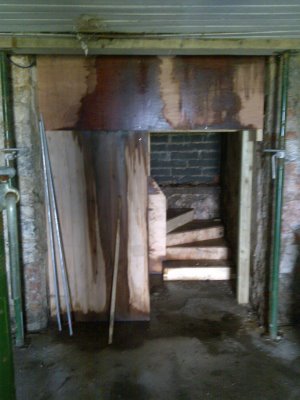
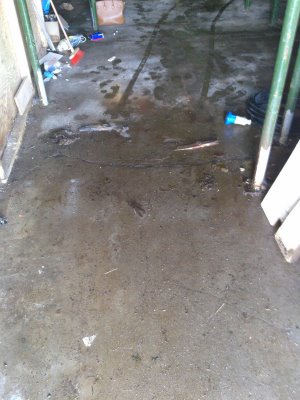
Even though I am used to the vagaries of Irish weather, when you organise an indoor event for the middle of July, you don’t expect that torrential rain will be a problem. I arrived in Skerries today to start the preparations for the opening of Tattered Outlaws of History on Thursday. When we opened the door in to the tower it was clear that the drips and dampness we’d had to contend with in the past had escalated to extensive leaks that didn’t bode well for our system of electrical wiring and fancy plasma screen set up. More heavy showers are forecast for the next few days.
Fortunately, the water damage was mostly on the perimeter of the first floor, leaving the place where the screens will go relatively dry. We installed the TVs and covered them for the night with plastic shrouds. I know the electricity works so if they survive tonight, Dan and I will test them more fully tomorrow.
They keep you on your toes, these buildings. But returning to them, I feel very happy that they are part of my physical memory now. I’ve been rain-soaked, sunburned and wind-buffeted on them; I’ve rubbed my skin on their stone, slid on the tussocks of grass that have survived in their cracks. I know what the towers feel like and how they dance.
Woolworth’s in Leytonstone: A room of one’s own
I’ve been discussing with Waltham Forest Council the possibility of using the empty Woolworths in Leytonstone for an evening of Waltham Forest choreography. I’d been calling the evening Pick’n’Mix but Leytonstone Arts Trail has used the Woolworths first and adopted my title too. They’ve put part of their annual visual art exhibition into the Woolworths and the opening party last Friday was packed with people of all ages. They’ve really generated a buzz and media interest, reminding people what artists can do with limited resources. The co-operation of the council has been a great help too and will be very important in ensuring the success of Pick’n’Mix: a dance selection later on in the year.
In the meantime, the organising committee of the Arts Trail has generously allowed me to use one of the spaces in the Woolworths that they can’t open to the public because it is not equally accessible. It’s really exciting to have access to a space relatively close to home that I can use for free to doodle physical ideas. It’s not a sprung floor but it’s wooden with tiles – not an ideal space but tall and big enough for me to move around in. I don’t cover quite as much ground these days.
The floor was really dirty today but given that I’ve rolled around in bird droppings, it’s not bad. I started the cleaning process, knowing it will take a few more attempts but because I want to get rid of the surface stickiness that makes sliding around uncomfortable and difficult.
The space used to be the locker room of the employees and has lots of notice reminding them that they are being watched even in this ‘backstage’ area.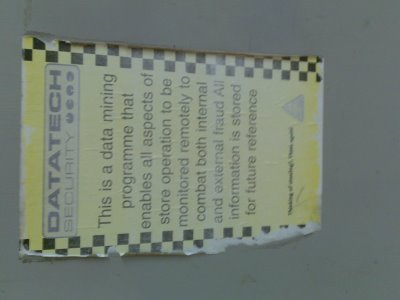
I wonder what new dance will emerge for this left behind space.
Cosán Dearg – some years on
Cosán Dearg is a piece I made in 2005 with director Jason Byrne(whose Phaedra’s Love won best production last year in the Irish Times Theatre awards), composer Julie Feeney (whose critically acclaimed new album Pages is just released) and fellow performer Bernadette Iglich . It grew out of a collaboration that started when we were participants in a workshop organised by the Dublin Fringe Festival held at the Annaghmakerrig artists’ retreat.
While we were in the last stages of making the piece, a film company called Scannán Dobharchú made a documentary about us. It wasn’t an easy process, as I was anxious that the filming wouldn’t interfere with the delicate last stages of our rehearsals. There were tensions in our collaboration that I was afraid the documentary might sensationalise. However, I think Scannán Dobharchú did a great job and it’s a pleasure after all this time to see something of our work.
The documentary was completed in 2005 but never screened by TG4, the programme commissioners. Then, out of the blue, it appeared last year unannounced. Maybe there was a slot to fill? Maybe they lost it? But at least I’ve been able to get a copy now and here’s an excerpt from the end of the programme.
It contains some tenebrously tasteful nudity
Tattered Outlaws test installation
I arrived in Skerries yesterday to see what our installation of twelve Tattered Outlaws films look like. From the Skerries tower you can see the Martello Tower on Shenick’s Island, so I’m reminded straight away that however solitary each tower seems, it is an echo of another tower. It is part of a family that share a structural DNA, however the vagaries of history may have shaped its members in different ways.
We’ve persuaded the council to clean out the layers of bird droppings from the tower but it’s still a rough environment with scaffolding supporting the rotting ceiling and floor.
Dan has been working with Pickle to install the screens, stairs and viewing platform so that when I arrive, I can climb from the gloom of the ground floor to the viewing platform and be dazzled by the unexpected brightness of screens. Dan has designed such an elegant and simple construction that the screens seem to grow out of the damp floor like high-tech mushrooms. That’s a good thing.
It was wonderful to be able to show the work to a variety of people today: for many the excitement of the project lies in the opportunity to be inside the towers and to see what the other towers look like. It occurred to be that the towers are a bit like the areas subconscious – a repository of stories with not quite understood associations, present but mysterious. Reading the towers as an unconscious helps me make sense of the place of the dancing bodies on the towers. I think the movement can communicate the less rational associations of the towers, their strangeness and the permission they, as outlaw buildings, give people to shelter the outlaw aspects of their consciousness.
We’ve had to dismantle the installation now to protect the screens from damp and damage until July when the exhibition opens properly. There are still jobs to do, as Dan’s list suggests, but we know it can work.




